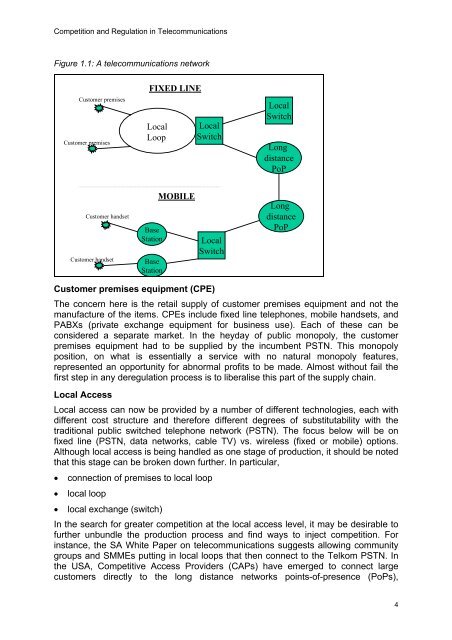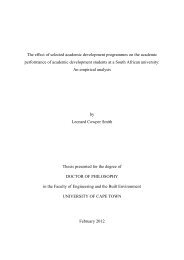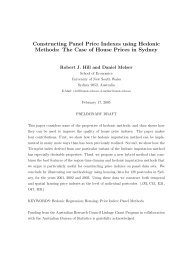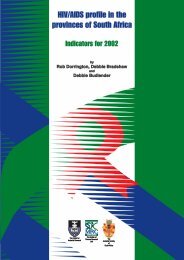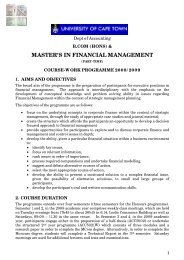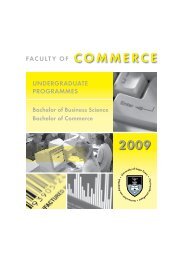Competition and Regulation in the Telecommunications Industry in ...
Competition and Regulation in the Telecommunications Industry in ...
Competition and Regulation in the Telecommunications Industry in ...
Create successful ePaper yourself
Turn your PDF publications into a flip-book with our unique Google optimized e-Paper software.
<strong>Competition</strong> <strong>and</strong> <strong>Regulation</strong> <strong>in</strong> <strong>Telecommunications</strong>Figure 1.1: A telecommunications networkCustomer premisesCustomer premisesFIXED LINELocalLoopLocalSwitchLocalSwitchLongdistancePoPCustomer h<strong>and</strong>setCustomer h<strong>and</strong>setBaseStationBaseStationMOBILELocalSwitchLongdistancePoPCustomer premises equipment (CPE)The concern here is <strong>the</strong> retail supply of customer premises equipment <strong>and</strong> not <strong>the</strong>manufacture of <strong>the</strong> items. CPEs <strong>in</strong>clude fixed l<strong>in</strong>e telephones, mobile h<strong>and</strong>sets, <strong>and</strong>PABXs (private exchange equipment for bus<strong>in</strong>ess use). Each of <strong>the</strong>se can beconsidered a separate market. In <strong>the</strong> heyday of public monopoly, <strong>the</strong> customerpremises equipment had to be supplied by <strong>the</strong> <strong>in</strong>cumbent PSTN. This monopolyposition, on what is essentially a service with no natural monopoly features,represented an opportunity for abnormal profits to be made. Almost without fail <strong>the</strong>first step <strong>in</strong> any deregulation process is to liberalise this part of <strong>the</strong> supply cha<strong>in</strong>.Local AccessLocal access can now be provided by a number of different technologies, each withdifferent cost structure <strong>and</strong> <strong>the</strong>refore different degrees of substitutability with <strong>the</strong>traditional public switched telephone network (PSTN). The focus below will be onfixed l<strong>in</strong>e (PSTN, data networks, cable TV) vs. wireless (fixed or mobile) options.Although local access is be<strong>in</strong>g h<strong>and</strong>led as one stage of production, it should be notedthat this stage can be broken down fur<strong>the</strong>r. In particular,• connection of premises to local loop• local loop• local exchange (switch)In <strong>the</strong> search for greater competition at <strong>the</strong> local access level, it may be desirable tofur<strong>the</strong>r unbundle <strong>the</strong> production process <strong>and</strong> f<strong>in</strong>d ways to <strong>in</strong>ject competition. For<strong>in</strong>stance, <strong>the</strong> SA White Paper on telecommunications suggests allow<strong>in</strong>g communitygroups <strong>and</strong> SMMEs putt<strong>in</strong>g <strong>in</strong> local loops that <strong>the</strong>n connect to <strong>the</strong> Telkom PSTN. In<strong>the</strong> USA, Competitive Access Providers (CAPs) have emerged to connect largecustomers directly to <strong>the</strong> long distance networks po<strong>in</strong>ts-of-presence (PoPs),4


